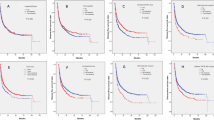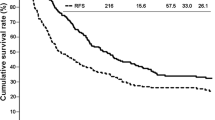Abstract
Background
The purpose of this study was to clarify the clinicopathologic characteristics and surgical outcomes of patients with the mass-forming (MF) plus periductal infiltrating (PI) type of intrahepatic cholangiocellular carcinoma (ICC).
Methods
Between January 1, 1998, and December 31, 2004, a total of 94 patients with ICC underwent macroscopic curative resection, and the macroscopic type of the tumors was assessed prospectively. Among the 74 patients with the MF type (n = 46) and the MF plus PI type (n = 28) of ICC, multivariate analysis was conducted to identify the potential prognostic factors. The clinicopathologic data of the two groups were compared.
Results
The results revealed two independent prognostic factors: presence/absence of intrahepatic metastasis and the macroscopic type of the tumor. ICCs categorized macroscopically as the MF plus PI type were significantly associated with jaundice (p < 0.001), bile duct invasion (p < 0.001), portal vein invasion (p = 0.025), lymph node involvement (p = 0.017), and positive surgical margin (p = 0.038).
Conclusion
Identification of the macroscopic type of the tumor is useful for predicting survival after hepatectomy in patients with ICC. The MF plus PI type of ICC appears to have a more unfavorable prognosis, even after radical surgery, than the MF type of ICC.

Similar content being viewed by others
References
Liver Cancer Study group of Japan (1990) Primary liver cancer in Japan: clinicopathologic features and results of surgical treatment. Ann Surg 211:277–287
Craig JR, Peters RL, Edmondson HA (1989) Tumors of the liver and intrahepatic bile duct. In: Hartmann WH, editor. Atlas of tumor pathology. 2nd Series. Fascicle 26. Armed Forces Institute of Pathology, Washington, DC
Patel T (2001) Increasing incidence and mortality of primary intrahepatic cholangiocarcinoma in the United States. Hepatology 33:1353–1357
Liver Cancer Study Group of Japan (1997) Classification of primary liver cancer. 1st edn. Kanehara, Tokyo, pp 6–7
Nakajima T, Kondo Y, Miyazaki M, et al. (1988) A histopathologic study of 102 cases of intrahepatic cholangiocarcinoma: histologic classification and modes of spreading. Hum Pathol 19:1228–1234
Yamamoto J, Kosuge T, Takayama T, et al. (1992) Surgical treatment of intrahepatic cholangiocarcinoma: four patients surviving more than five years. Surgery 111:617–622
Sasaki A, Aramaki M, Kawano K, et al. (1998) Intrahepatic peripheral cholangiocarcinoma: mode of spread and choice of surgical treatment. Br J Surg 85:1206–1209
Sano T, Kamiya J, Nagino M, et al. (1999) Macroscopic classification and preoperative diagnosis of intrahepatic cholangiocarcinoma in Japan. J Hepatobiliary Pancreat Surg 6:101–107
Yamanaka N, Okamoto E, Ando T, et al. (1995) Clinocopathologic spectrum of resected extraductal mass-forming intrahepatic cholangiocarcinoma. Cancer 76:2449–2456
Yamamoto M, Takasaki K, Yoshikawa T, et al. (1988) Does gross appearance indicate prognosis in intrahepatic cholangiocarcinoma? J Surg Oncol 69:162–167
Ohtsuka M, Ito F, Kimura H, et al. (2002) Results of surgical treatment for intrahepatic cholangiocarcinoma and clinicopathological factors influencing survival. Br J Surg 89:1525–1531
Yamasaki S (2003) Intrahepatic cholangiocarcinoma: macroscopic type and stage classification. J Hepatobiliary Pancreat Surg 10:288–291
Yeh CN, Jan YY, Yeh TS, et al (2004) Hepatic resection of the intraductal papillary type of peripheral cholangiocarcinoma. Ann Surg Oncol 11:606–611
Inoue K, Makuuchi M, Takayama K, et al. (2000) Long-term survival and prognostic factors in the surgical treatment of mass-forming type cholangiocarcinoma. Surgery 127:498–505
Cherqui D, Tantawi B, Alon R, et al. (1995) Intrahepatic cholangiocarcinoma: results of aggressive surgical management. Arch Surg 130:1073–1078
Lang H, Sotiropoulos GC, Frühauf NR, et al. (2005) Extended hepatectomy for intrahepatic cholangiocellular carcinoma (ICC)—when is it worthwhile? Single center experience with 27 resctions in 50 patients over 5-year period. Ann Surg 241:134–143
Kamada T, Saitou H, Takamura A, et al. (1996) The role of radiotherapy in the management of extrahepatic bile duct cancer: an analysis of 145 consecutive patients treated with intramural and/or external beam radiotherapy. Int J Radiat Oncol Biol Phys 34:767–774
Todoroki T, ohhara K, Kawamoto, et al. (2000) Benefits of radiotherapy after resection of locally advanced main hepatic duct carcinoma. Int J Radiat Oncol Biol Phys 46:69–127
Stein DE, Heron DE, Rosato EL, et al. (2005) Positive microscopic margins after outcome in lymph node-negative cholangiocarcinoma when resection is combined with adjuvant radiotherapy. Am J Clin Oncol 28:21–23
Shimada M, Yamashita Y, Aishima S, et al. (2001) Value of lymph node dissection during resection of intrahepatic cholangiocarcinoma. Br J Surg 88:1463–1466
Okabayashi T, Yamamoto J, Kosuge T, et al. (2001) A new staging system for mass-forming intrahepatic cholangiocarcinoma: analysis of preoperative and postoperative variables. Cancer 92:2374–2383
Nakagawa T, Kamiyama T, Kurauchi N, et al. (2005) Number of lymph node metastases is a significant prognostic factor in intrahepatic cholangiocarcinoma. World J Surg 29:728–733
Ercolani G, Grazi GL, Ravaioli M, et al. (2004) The role of lymphadenectomy for liver tumors: further consideration on the appropriateness of treatment strategy. Ann Surg 239:202–209
Acknowledgments
This study was supported by a Grant-in-Aid for cancer research from the Ministry of Health, Welfare, and Labor of Japan
Author information
Authors and Affiliations
Corresponding author
Rights and permissions
About this article
Cite this article
Shimada, K., Sano, T., Sakamoto, Y. et al. Surgical Outcomes of the Mass-Forming plus Periductal Infiltrating Types of Intrahepatic Cholangiocarcinoma: A Comparative Study with the Typical Mass-Forming Type of Intrahepatic Cholangiocarcinoma. World J Surg 31, 2016–2022 (2007). https://doi.org/10.1007/s00268-007-9194-0
Published:
Issue Date:
DOI: https://doi.org/10.1007/s00268-007-9194-0




